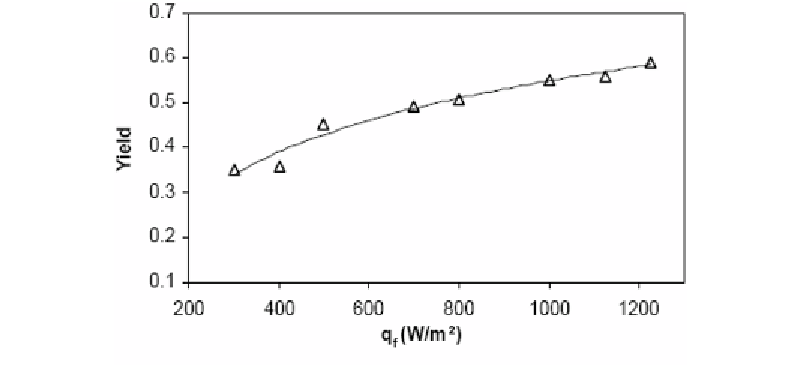Environmental Engineering Reference
In-Depth Information
b
Figure 3. Influence of the heating flux on the exchanged fluxes (a) and on the yield (b).(
m
feed
= 1.46l/h,
T
c
= 26°C,
T
feed
=23.87 °C).
The latent heat flux density, associated to the evaporation increases with the heating flux
density, hence the evaporated mass flow rate increases. On the same figure, the sensitive heat
flux density
q
out
evacuated by the brine has been represented.
q
out
increases with
q
f
but
remains always very low compared to
q
l
. It means that during evaporation the heat exchanges
are controlled by the latent heat flux associated to the phase change, in agreement with the
conclusion of [6].
To describe the behavior of the cell, the thermal yield has been defined as the ratio
q
l
/
q
f
of the latent heat flux density to the heat flux density provided to the system. Figure 3-b
presents the variation of this ratio with respect to the heat flux density. The yield of the cell
increases with the provide heat flux density, thus also with the latent heat flux density, but
always remains limited by a maximum value around 0.6.
Influence of the Temperature of Feed Water
According to Fick's law, the mass transfer between the film and the gas mixture inside
the cell is proportional to the concentration gradient at the liquid-gas interface. Thus, before
being able to evaporate, the water that runs on the heated wall first heat itself and reaches a
temperature so that its saturated concentration is larger than that of the surrounding gas
mixture. It results that if the temperature of the liquid which feeds the film, the phase change
and the yield of the cell are favored. This result is demonstrated on figure 4.
According to equation (1), when the heat flux density
q
f
is constant, a decrease of the
sensitive flux
q
out
must be compensated by an increase of the other terms of the second
member, in particular of the latent heat flux density. This result is confirmed in figure 4-a
where the values of
q
out
are decreasing with respect to
T
feed
and can even be for values of
T
feed
larger than about 40°C. Negative values of
q
out
mean that this term represents an inflow of
energy to the system that accompanies the inlet of preheated water in a medium of lower
temperature. The improvement of the yield that results from the increase of the feed

Search WWH ::

Custom Search